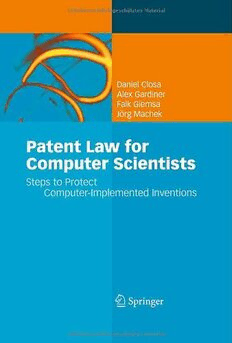
Patent Law for Computer Scientists: Steps to Protect Computer-Implemented Inventions PDF
197 Pages·2010·2.225 MB·English
Most books are stored in the elastic cloud where traffic is expensive. For this reason, we have a limit on daily download.
Preview Patent Law for Computer Scientists: Steps to Protect Computer-Implemented Inventions
Description:
Patent laws are different in many countries, and inventors are sometimes at a loss to understand which basic requirements should be satisfied if an invention is to be granted a patent. This is particularly true for inventions implemented on a computer. While roughly a third of all applications (and granted patents) relate, in one way or another, to a computer, applications where the innovation mainly resides in software or in a business method are treated differently by the major patent offices in the US (USPTO), Japan (JPO) and Europe (EPO). The authors start with a thorough introduction to patent laws and practices, and to related intellectual property rights, also explaining the procedures at the USPTO, JPO and EPO, and, in particular, the peculiarities in the treatment of applications centring on software or computers. Based on this theoretical description they then present, in a very structured way, a comprehensive set of case studies from differing areas including business methods, databases, graphical user interfaces and digital rights management. Each set starts with a short description and claim for the "invention", explains a patent examiner’s likely arguments, then eventually refines step by step to avoid basic reservations against the content. All of these case studies are based on real-world examples, and will thus give an inexperienced developer a strong sense of the level of technical detail and description that should be provided. Together, Closa, Gardiner, Giemsa and Machek have more than 70 years experience in the patent business. With their academic backgrounds in physics, electronics engineering and computer science, they know both the legal and the technological subtleties of computer-based inventions. With this book, they provide a guide to a patent examiner’s way of thinking in a clear and systematic manner, helping to prepare the first steps towards a successful patent application.
See more
The list of books you might like
Most books are stored in the elastic cloud where traffic is expensive. For this reason, we have a limit on daily download.
